 Thanks: 0
Thanks: 0
 Needs Pictures: 0
Needs Pictures: 0
 Picture(s) thanks: 0
Picture(s) thanks: 0
Results 1 to 14 of 14
Thread: Tooling for Feel
-
13th May 2013, 08:06 PM #1
 Tooling for Feel
Tooling for Feel
Derek, you use the LV router, and have designed and made granny tooth routers.
Are there substantial differences that make one preferred over the other?
I was asked this question in a thread on the LV router plane on WoodNet after I posted this picture of using the LV router plane for hinge mortices ..
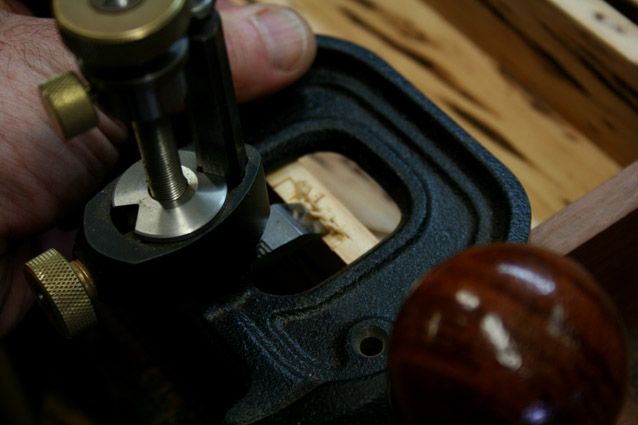
Here is another picture (from my review - but sporting a shopmade depth stop, which has since been replaced) ...

What stimulated the question was a recent post I made of a smaller wooden router plane I designed (borrowing a little from the ECE) and built ...
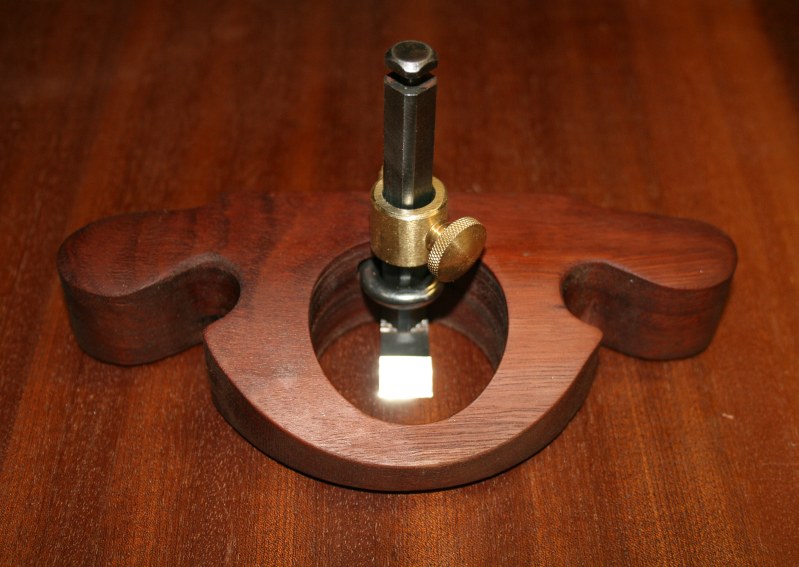
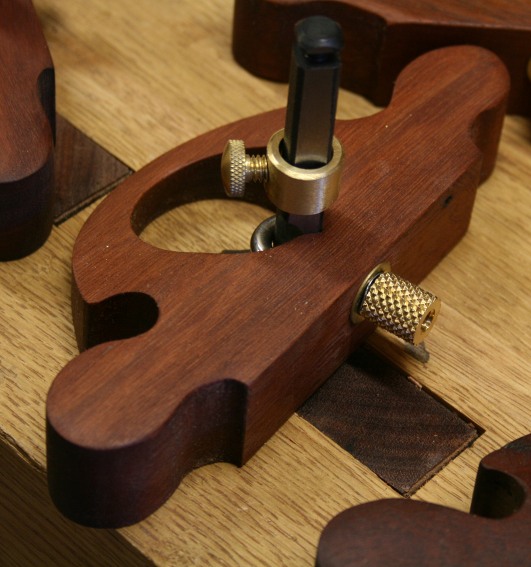
Keep in mind that the thread is about "feel" and not these router planes. What is "feel"? I think of this as the feedback you receive when the blade hits the wood. You know exactly what is going on at the coal face. It is akin to driving a big Cadillac with so much suspension that you float over the road never knowing whether there are bumps or potholes .... versus .... a Morgan, with its wooden chasis and hard suspension and direct steering. Made to go fast, and not great on the road, but completely involving.
One of the advantages of planing wood with a hand plane rather than a machine is that you get to know the surface of the wood (although sometimes too much of a good thing is a bad thing - such as this mongrel Curly Marri I am planing up for a blanket chest! ). When planing interlocked grain you feel when the plane is starting to struggle and resist cutting. You stop in mid shaving, adjust the stroke/depth of blade/direction of cut.
). When planing interlocked grain you feel when the plane is starting to struggle and resist cutting. You stop in mid shaving, adjust the stroke/depth of blade/direction of cut.
In my experience the difference in feedback varies in part with the centre of gravity. The further from the work surface, the lower the feedback. Conversely, the lower the centre of gravity, the greater the feedback. In part, feedback also depends on the "centre of effort". C of E is a yachting term to refer to the action of the wind on the sail - where it places it force ... low or high on the sail. Pressure at the top of the sail is different to pressure at the bottom of the sail. In a similar manner, force directed at the low end of the blade creates more stability and controlled power. For this reason, a plane with a low centre of gravity requires less effort to push than a plane with a high centre of gravity, for example, a traditional jointer versus a razee jointer ...


This is the reason I build razee woodies ... and yet I often return to the LV BU Jointer ...

Add to the equation a plane with a low centre of effort - a bevel up plane is an example of this - and you will understand their attractiveness to many. They are easy to push and easy to control.
I could make a similar case among backsaws - those with tall plates versus those with low plates. Some will argue that tenon saws benefit from a tall plate to aid in orientating in the vertical. I agree. I am only pointing out which feels easier to use. However we then get to dovetail saws, and a low plate saw, such as the Gramercy, has a very different feel to high plate saws (with a similar teeth configuration).
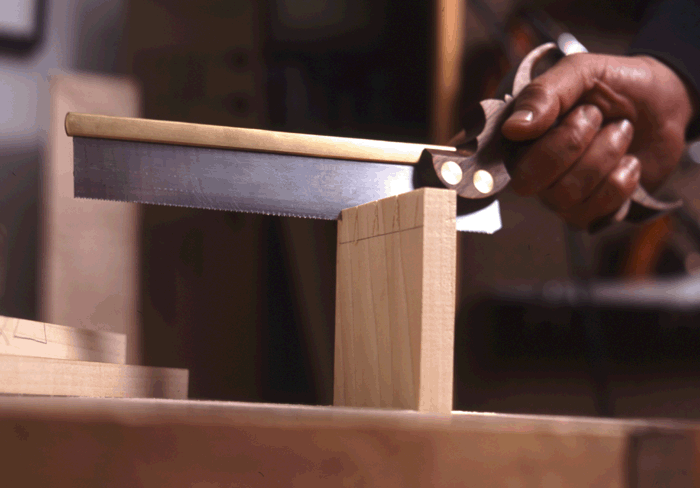
So, what about the router plane?
I recall a comparison of router planes by Chris Schwarz where he preferred the high knobs of the LN/Stanley over the lower, canted knobs of the LV. Interestingly, he commented that "the rakish handles (of the LV) feel better when you grip them with your pinky fingers at the base of the tool (palms on the sides of the knobs)". In other words, when you are pushing the router plane from directly behind the blade. (Link: Lie-Nielsen Large Router Plane - Popular Woodworking Magazine).
This is the way I often use the LV router plane - pushing with my thumbs directly behind the blade (not in the picture above, where the router plane was being held one-handed for the photo of the hinge mortice). I prefer the lower slung LV knobs to the upright LN/Stanley knobs because they direct the C of E downward. (I must admit that none of this occurred to me when I was comparing the Stanley and the LV in my review written in 2006: The Veritas Router Plane)
When I built the wooden router plane, it was expressively designed to be used this way - thumbs behind the blade. This creates not only a low centre of gravity, but a low C of E. To describe it, it feels closer to paring with a short chisel (see ... short butt chisels for feel verses long paring chisels for directionality).
There is plenty of power in this small router plane, in spite of the low weight, since the centre of effort minimises wasted energy. The high centre of effort importantly maximises the feedback one receives, and it is this that makes it my current go-to router plane.
A rather long winded answer to a short question.
Regards from Perth
DerekVisit www.inthewoodshop.com for tutorials on constructing handtools, handtool reviews, and my trials and tribulations with furniture builds.
-
13th May 2013 08:06 PM # ADSGoogle Adsense Advertisement
- Join Date
- Always
- Location
- Advertising world
- Posts
- Many
-
14th May 2013, 10:28 AM #2

Derek, all good stuff. I think putting the effort as directly as possible behind the 'line of resistance' works for any tool. For most of my life I have self-selected tools that allow this. For much of that time it was intuitive; I just knew I preferred the feel of one tool over another. It was only when I started making saws seriously that I gave it some thought, and came to some similar conclusions.
Which makes me wonder a bit at the Grammercy saw you show. I haven't held one in my hands, let alone used one, so I am probably on dangerous turf, but to my eye, the handle on it looks plain wrong - much too high up for my taste. I'm guessing it's like that partly to give the handle clearance, but I long ago decided a dedicated dovetailing saw doesn't need handle clearance because the handle doesn't come near any obstructions, unlike a general-purpose saw used on a bench-hook, for e.g.. So you can bring the grip down as far as you like. This is what I much prefer:
D-tail 220mm blade.jpg
With this arrangement, I feel in complete control of the saw (as long I watch what I'm doing, of course, I can still get distracted & make a bum cut without trying too hard.... )
)
Cheers,IW
-
14th May 2013, 10:34 AM #3

Thought provoking, thanks
 regards
regards
Nick
veni, vidi, tornavi
Without wood it's just ...
-
14th May 2013, 10:11 PM #4
 Tooling for Feel
Tooling for Feel
Funny you should mention the razee jointer because I was just thinking of doctoring my old school brick to get the handle lower. It's the one woodie I have that I find a little uncomfortable and it is also the only one with a top mounted handle.
Mind you, I work on an old dining table at the moment so I'm a little reluctant to change things to suit working at hip height ...I'll just make the other bits smaller.
...I'll just make the other bits smaller.
-
14th May 2013, 11:00 PM #5

Hi Ian
The Gramercy is a very light saw. In addition to the low plate, the brass back is about half the mass of most dovetail saws (such as a LN), and the handle is also a little slimmer than most. When I saw pictures of it my first thought was the same as yours. I was in New York at New Year and spent a day with Joel Moskowitz at Tool for Working Wood (incidentally, the name "Gramercy" comes from the park around the corner of his home, where Lynndy and I had dinner with Joel and his family). When I had the chance to use the dovetail saw I discovered that it encouraged a light grip, and this allowed the saw to do the work. It was perfectly balanced. One followed me home. Indeed, it reminded me of another dovetail saw I have, this one ...
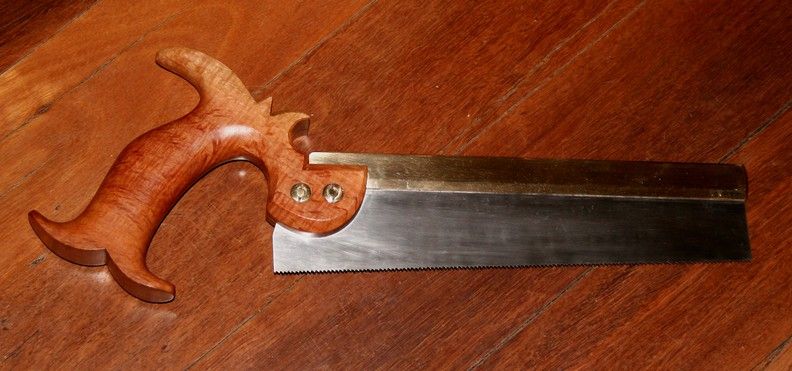
(For those that do not get the inside joke, the saw is one that Ian made for me).
Incidentally Ian, the hang on that dovetail saw of yours (in your post) looks too low for my comfort (very different from the saw above). On the other hand, I've just noticed the shape of the handle. It resembles those I made a while back, with a "plane" type handle - thicker section at the lower end to lift the hand upward ...
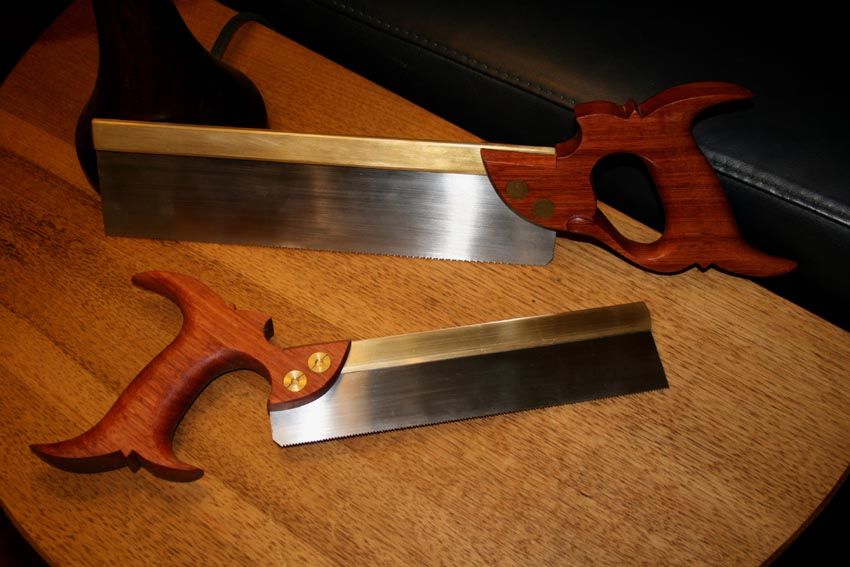
Back to the topic.
I think that the point to make is that feedback and feel may be accounted for by a number of factors, only one of which is the kinesthetic. For some it is visual. For others it is the sound the tool makes on wood.
Joel may have designed the saw to have a higher hang than common. Perhaps he places more emphasis - personally - on a visual aspect? And it is my reaction to use it with a lighter-than-usual touch because that is how I respond to a tool? Does this stimulate others here to consider their own style?
It is probably not possible to focus on one of these modalities to the exclusion of the others, but likely one be in the foreground, the others remain in the background, as priorities determine. For example, as mentioned before, a high sided jointer or a wide plate saw will offer feedback about the vertical, however these are not desired each and every time. I built two smoothers recently, both with a 55 degree bed, and the same length. One is a classic coffin (high) and the other a classic Krenov (low). They work equally well. My preference is the latter, which indicates that I place greater focus on the kinesthetic than visual when planing.
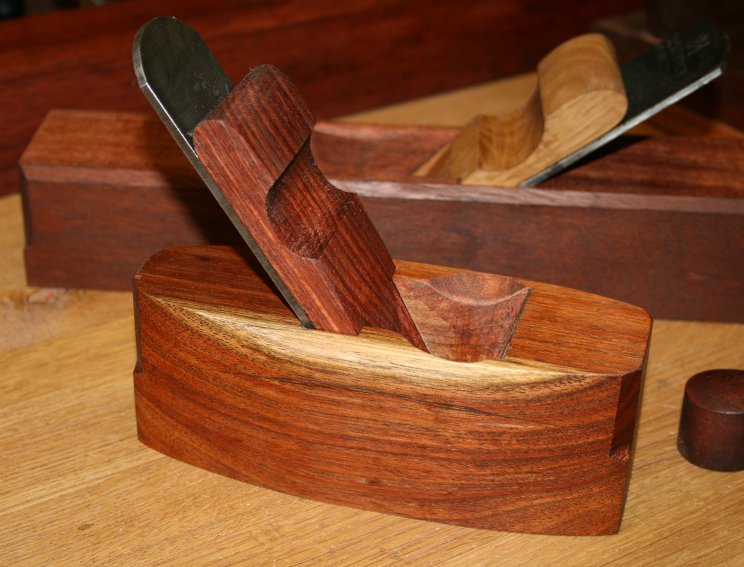

Regards from Perth
DerekVisit www.inthewoodshop.com for tutorials on constructing handtools, handtool reviews, and my trials and tribulations with furniture builds.
-
14th May 2013, 11:54 PM #6
-
15th May 2013, 12:11 AM #7

Hi Ian and Derek
saw hang -- what a wonderful topic that could go on for a month of Sundays
what I've divined so far on this journey comes down to this
for every user (height, arm length, hand size, wrist strength) there's a hang that is just right for the sawing task being undertaken. Vary the working height, and a hang that was just so now needs the wrist to be cocked a little differently, or the arm motion to be modified to something that feels not quite right.
I suspect that the subtely of a hand saw's hang has largely been lost and I await it's rediscoveryregards from Alberta, Canada
ian
-
15th May 2013, 01:15 AM #8

+1 Ian.
There's nothing like fine detail that's well researched, thought through, collated & sequenced, and above all well written. This allows people such as myself, near the beginning of the journey, to make much better initial choices and learn at a significantly accelerated pace. Speaking for myself, it is mostly still knowledge, but it's kinda like reading the Kama Sutra as a virgin - can't wait to put it into practice (and still can't ).
).
As an example of how this benefits those with considerably less (to not much) knowledge, I have started my small-saw journey with one of Ian's saws which is a carbon copy of his own that he posted here. That is to say that I do not have, and will never will have, any idea what it's like to use a saw that's less than excellent by anyone's standard. Although it's yet to cut a dovetail, it's just a gas little saw to use for any amount of small tasks.
So Derek (and Ians), thank you for starting this and many other discussions like it.
A little more back OT:
Noel Liogier has a client (I think it might be Gille Frenchsurname with the good legs Ian (ian Ian) ) who doesn't like to have handles on his rasps because he gets a much better feel for what's going on underneath it. Not quite what Derek's talking about, I know, but certainly in the same chapter.
) who doesn't like to have handles on his rasps because he gets a much better feel for what's going on underneath it. Not quite what Derek's talking about, I know, but certainly in the same chapter.
Cheers
Brett
-
15th May 2013, 01:29 AM #9

I'm not an experienced woodworker, but it is hard to shut me up, so I'll put 2c in.
For one ... for low centre of effort I guess the japanese probably have it covered
I have very much noticed the difference between wooden plane on wood and iron/infill planes.
I think I might suggest perhaps appropriate heft factors into the picture ... unless it is just me.
I very much enjoy using that big english try plane I put up a clip of ... and don't especially like the stanley #62. It feels sort of 'insubstantial'. I have tried the LN version at the woodshow and was still not moved.
On the other hand, I love my ECE smoother plane ... which is not a lightweight but not solid-heavy ... but I have never yet particularly connected to a wooden coffin plane. I think the deal there is to do with the comfort of holding them.
And I definitely agree with the 'sound factor' as feedback ... in planing ... sawing ... could even stretch that to knocking out taper pins in machinery ... but getting off on a tangent.
Cheers,
Paul
-
15th May 2013, 11:03 AM #10

Derek I was about to ask when did you buy the metal lathe to make your knurled bits and decided to check your posts before doing so
 I should have known a man with your talents has ways and means
I should have known a man with your talents has ways and means 


If I find the link somewhere on the net is a fellow who has adapted his Jet Mini to do metal working such as Ali and Brass and includes knurling using a cross slide and knurler.
-
15th May 2013, 11:22 AM #11

Yep, absolutely agree.
However, I don't think there is a huge amount of subtilty in old handles, to be honest. I think they figured out a few angles & positions that covered the majority of uses and users' needs. If you compare old backsaw handles, from the mid 1800s to the mid 190s, you'll not find a huge amount of difference in hang angles. Well, not on the 60 or 70 I've seen & held, which might be a dangerously small sample.
If you want subtle, I think you have to roll your own, and what you like best will be determined by your task, your bench height, your preferred forearm angle and the flexibility of your wrist (& just plain personal preference!). So it's not in the least surprising to me that Derek thinks my preferred dovetail saw looks not right to his eyes. I've had a very experienced w'worker pick it up & give it a stroke or two, grimace, & put it down, yet others have tried it, loved it, & wanted one on the spot. I was careful to point out that I have never wielded the Grammercy, it just LOOKS a bit awkward to me with its high set, & high angle, grip. But Derek says it drives well, and I think he has a bit of an idea of what a saw is... It fits my theory that there are several different factors that make a tool work well, and you can vary the parts on one side of the equation, but still have them add up to the same total on the other.....
It fits my theory that there are several different factors that make a tool work well, and you can vary the parts on one side of the equation, but still have them add up to the same total on the other.....
I like discussions like this because I think there are basic principles that apply to tool design, & it helps me to get a feel for the 'normal' range of likes & dislikes. The really tricky bit is the mixing & matching of these to suit individuals!
Cheers,IW
-
16th May 2013, 12:14 AM #12

well if you've handled 60 or 70 your sample size is much larger than mine,
However, a few years ago now the bi monthly meeting of the Sydney based The Traditional Tools Group (www.TTTG.org.au) was about hand saws. The manufacture date of the saws present ranged from about 1800 through to the early 2000s. Among the saws present were dovetail saws from Mike Wenzloff and Lie Nielsen, the LN carcas saw (the two LN saws are the same as those produced by Mike Tarrant in the late 1990s, which in turn are copies of saws last made in the late 1800s) plus examples from Spear and Jackson, Disston, and other early makers. What stood out was the difference in hang between the DT saws. The hang of the Wenzloff was in my wrist exactly the same as that on a saw from the late 1800s, while the L-N was ever so slightly different. I must stress that the Lie Nielsen DT saw is superb in use, and yes I have one and love it. I don't know which old saw the Wenzloff was based on -- nowadays Mike produces a number of DT saws each based on a different early manufacturer -- and the saw I was using was at the time only available through Lee Valley -- But that subtle difference in hang between the LN and Wenzlof saws could make one wonder if in days gone by you walked into a saw merchant and tried a number of saws for size -- much like trying on a suit -- before settling on the saws that felt just right for you.
The Keyton saws in the Seaton tool chest are perhaps illustrative
Seaton had 4 back saws in his chest
Tenon -- 19in long, 10 point, rip, closed handle
Sash -- 14in long, 13 point, rip, closed handle
Carcass -- 11in long, 14 points, cross cut, open handle
Dovetail -- 9 in long, 19 points, rip, open handle
the angle between the saw's back and where the fingers grasp the handle is different on each saw, suggesting to me some subtley I don't fully comprehend between the angle of the wrist and the sawing taskregards from Alberta, Canada
ian
-
16th May 2013, 12:49 PM #13

Ian - I have expounded on my theory of saw grip elsewhere, but at the risk of being boring, I think it boils down to the angle of your wrist during the sawing process. If you hold your arm out in a sawing position (i.e. with closed fist vertical), you can soon prove to yourself that you have a far greater range of rotation in your elbow than your wrist, relative to your forearm. My aim is to get the grip at an angle that will put the wrist in a mid or 'neutral' position during the sawing operation. This gives you a little leeway in both directions, but mostly you should be working with the wrist at it's most comfortable 'neutral' position. [edit: wrist angle is important with other pushed tools, like planes, too]. Obviously, the actual grip angle depends on what level you are working at - bench top height, higher, or lower, and has to make due allowance for your body proportions (relative length of the two main parts of your arm, etc.). If making a saw for myself, I know what I intend using it for, and after making (too) many saws, I can set the grip angle where I want it fairly reliably. But while I've gotten pretty good at sorting this out for myself, it's an entirely different matter making a saw for someone else! You really need the person to be there in person to sort out the variables.
Definitely, it would have been an advantage to be able to walk into a shop & heft a wide range of saws to pick the one you liked best, as in days of old. However, the other factors that affect a saw's feel, such as overall weight, length, size of finger hole, thickness and width of the grip, usually have a more immediate impact when you pick a saw up and heft it. You really don't fully appreciate grip angles until you've got the saw working in a real situation. For me, if all else is right, and the grip angle is optimised for what I'm doing, it's like changing up into top gear, - things start rolling along very smoothly & quickly.
You can get used to a saw no matter what its grip angle - either you intuitively place the work in the 'right' position for you, or you get used to working with your wrist a bit over-flexed or over-extended. Maybe it's not until you get a bit arthritic or your joints become less flexible that you fully appreciate this!
I have a theory that one of the reasons I find grips on old saws with open handles a bit high for operations 200mm or so above bench height is that we 'moderns' have snuck bench heights up quite a bit, and tend to put work up higher in general. Dunno, that may be off the mark, but it's been pretty easy for me to convince most others that a somewhat more vertical grip angle works better for work up around elbow level, if I give them a couple of saws with different handles, to try. But not everyone, as I said above, there are other factors that influence the overall feel, and the personal preference factor has been, & remains, a very important one!
Cheers,IW
-
17th May 2013, 12:44 AM #14

I don't think you're off the mark.
In my hands the rear handle used on the Veritas BU planes feels better on a high bench, while the more "normal" stanley rear handle feels better on low benches
the same is true for saws -- I try and place the work at the height which makes sawing most comfortableregards from Alberta, Canada
ian
Similar Threads
-
How do Others Feel?
By Wood Borer in forum FORUMS INFO, HELP, DISCUSSION & FEEDBACKReplies: 92Last Post: 17th April 2008, 04:15 PM -
I should feel guilty......
By Bleedin Thumb in forum MusicReplies: 7Last Post: 10th July 2007, 09:42 AM -
Don't feel like it tonite....
By WoodyKnot in forum WOODIES JOKESReplies: 3Last Post: 18th October 2006, 10:56 PM -
I feel better now
By Gumby in forum TRITON / GMCReplies: 8Last Post: 10th March 2004, 05:59 PM



 Likes:
Likes: 


 Reply With Quote
Reply With Quote

